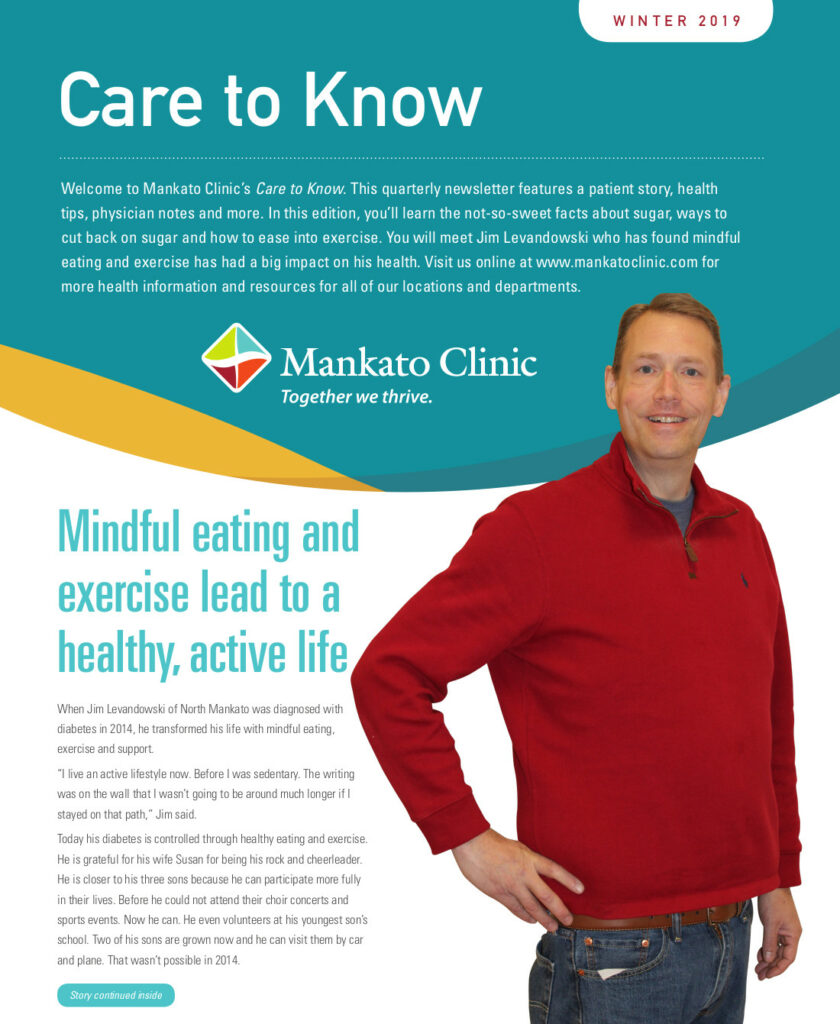Mindful Eating and Exercise Lead to a Healthy, Active Life
January 17, 2019

When Jim Levandowski of North Mankato was diagnosed with diabetes in 2014, he transformed his life with mindful eating, exercise and support.
“I live an active lifestyle now. Before I was sedentary. The writing was on the wall that I wasn’t going to be around much longer if I stayed on that path,” Jim said.
Today his diabetes is controlled through healthy eating and exercise. He is grateful for his wife Susan for being his rock and cheerleader. He is closer to his three sons because he can participate more fully in their lives. Before he could not attend their choir concerts and sports events. Now he can. He even volunteers at his youngest son’s school. Two of his sons are grown now and he can visit them by car and plane. That wasn’t possible in 2014.
Mankato Clinic Family Physician Dr. Michael Fraley referred Jim to the Diabetes and Nutrition Education Center. He learned to manage his diabetes through blood glucose monitoring and understanding how food choices impact his blood glucose levels. He also learned to balance carbohydrates with protein, vegetables and a healthy fat to slow down digestion and prevent blood sugar spikes. Within six months, he did not require insulin therapy.
“I really had a better idea what I was doing as far as my diet,” Jim said.
To prepare for bariatric surgery in 2016, Jim returned to the Diabetes and Nutrition Education center to work with Erin Gonzalez, RD, LD, to assist with long-term behavioral change. Erin introduced Jim to mindful eating, an approach that focuses on understanding his relationship with food. Erin partners with Connie Meyer, licensed independent clinical social worker, and Darcie Jacobs, Psy.D., to give patients the tools of mindful eating.
“Mindful eating allows us to become more present and intentional around our food choices while relearning to be the expert of our own nutritional needs and body cues. Our goal is to feel better at the end of eating then we did when we started. If we become present and notice how eating experiences impact our energy, mood, sleep, health, we are more likely to make eating decisions that balance eating for enjoyment and nourishment. Your body naturally seeks balance if you listen to it,” Erin said.
Mindful eating changed Jim’s life. He had tried diets, but the diets were short-term fixes not a long-term solution. He learned to listen to his body cues to tell him when to eat and when he was full.
“When I reach a comfortable level, I stop and evaluate if I’m full. If I wait 15 minutes and I’m still hungry, then I can eat a little more,” Jim said.
Jim realized he was mindlessly eating and reaching for food out of boredom, stress, sadness or anxiety. He addressed his mental health issues by seeing professionals in the Mankato Clinic Psychology and Psychiatry departments.
“You do need that support. You can’t fight mental health on your own,” Jim said.
Jim was challenged by back pain which made it difficult to exercise. He went to a physical therapist and began exercising in a therapy pool. Eventually Jim progressed to a mix of cardiovascular exercises, strengthening and stretching which he does five times a week. His physical therapist developed the workouts to target his range of motion. He also walks in the Madison East Center and recently joined a gym. He still needs medication to manage his back pain, but just enough so he can exercise.
“Exercise has given me a lot more energy, drive and stamina to do daily life activities. Before I was stuck in my chair,” he said.
All told, Jim lost 240 pounds with diet, exercise and surgery. He is sharing what he learned by leading a mindful eating support group in the community. They meet regularly for open discussion, workbook activities and expert speakers.
“I’ve learned so much during this process. I knew I wanted to share this with other people so they could experience this same success. We’ve seen people follow through with their goals and make substantial changes,” he said.
Jim was not one to ask for help. Now his advice to others who are struggling with obesity and chronic conditions is to reach out for professional help and look for resources in your community.
“I feel like I’m 30 again,” Jim said. “When my sons have grandkids I’ll be able to play with them.”
Learn more about our Diabetes and Nutrtion Education Center.